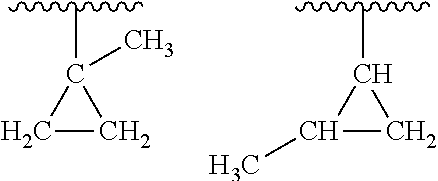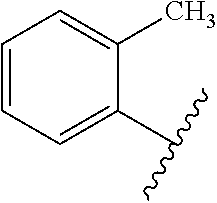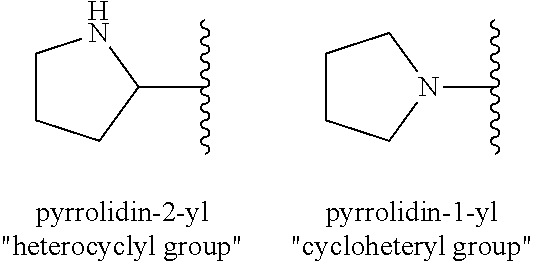Oligomerization of olefin waxes using metallocene-based catalyst systems
a technology of metallocene-based catalysts and oligomerization, which is applied in the direction of physical/chemical process catalysts, hydrocarbon oil treatment products, organic-compound/hydride/coordination complex catalysts, etc., to achieve the effects of increasing kinematic viscosity, reducing needle penetration, and increasing melt poin
- Summary
- Abstract
- Description
- Claims
- Application Information
AI Technical Summary
Benefits of technology
Problems solved by technology
Method used
Image
Examples
example 1
Under air- and moisture-free conditions, 50 g of CPChem C20 / 24 normal alpha olefin wax, as described and disclosed in this application, was heated to 75° C. with stirring, and purged with nitrogen for several hours. To the heated and purged wax was added 1000 molar equivalents (Al:Zr) of MMAO-3A (Akzo Nobel) followed immediately by 2.6 mg of Metallocene 1 dissolved 2.6 mL of anhydrous toluene. The reaction was maintained at 75° C., with stirring and under an inert atmosphere (dry nitrogen) for 3 days. After this time the reaction solution was poured warm (in the air) into a mixture of excess methanol and acetone sufficient to precipitate all the solids from the mixture. The solution was then decanted to remove the liquids. The solids were then washed thoroughly with heptane and pentane. During the washing procedure, the solids were crushed using a pestle to help dissolve any heptane and pentane soluble materials. After washing, 41 g of solids were isolated (83% isolated yield). Comp...
example 2
Under air- and moisture-free conditions, 60 g of CPChem C26 / 28 normal alpha olefin wax was heated to 75° C. with stirring, and purged with nitrogen for several hours. To the heated and purged wax was added 1000 equivalents (Al:Zr) of MMAO-3A followed immediately by 2.6 mg of Metallocene I dissolved 2.6 mL of toluene. The reaction was maintained at 75° C., with stirring and under inert atmosphere, for 18 hours. The reaction solution was then poured, hot, into heptane. The solution was then decanted to remove the liquids. The solids were then washed thoroughly with heptane, which solubilizes the starting wax, followed by pentane to remove the heptane. During the washing procedure, the solids were crushed using a pestle to help dissolve any heptane and pentane soluble materials. After washing, 34 g of solids were isolated (83% isolated yield). Comparison of a 0.4% solution of the starting material and a 0.4% solution of the product in xylene using gas chromatography indicated that isol...
example 3
Under air- and moisture-free conditions, 60 g of CPChem C30+HA normal alpha olefin wax was heated to 75° C. with stirring, and purged with nitrogen for several hours. To the heated and purged wax was added 1000 equivalents (Al:Zr) of MMAO-3A followed immediately by 2.6 mg of Metallocene I dissolved 2.6 mL of toluene. The reaction was maintained at 75° C., with stirring and under inert atmosphere, for 18 hours. The reaction solution was then poured, hot, into heptane. The solution was then decanted to remove the liquids. The solids were then washed thoroughly with heptane and pentane. During the washing procedure, the solids were crushed using a pestle to help dissolve any heptane and pentane soluble materials. After washing, 46 g of solids were isolated (77% isolated yield). Comparison of a 0.4% solution of the starting material and a 0.4% solution of the product in xylene using gas chromatography indicated that isolated solid sample contained about 56% olefin wax oligomers and 44% ...
PUM
| Property | Measurement | Unit |
|---|---|---|
| Temperature | aaaaa | aaaaa |
| Temperature | aaaaa | aaaaa |
| Temperature | aaaaa | aaaaa |
Abstract
Description
Claims
Application Information
 Login to View More
Login to View More - R&D
- Intellectual Property
- Life Sciences
- Materials
- Tech Scout
- Unparalleled Data Quality
- Higher Quality Content
- 60% Fewer Hallucinations
Browse by: Latest US Patents, China's latest patents, Technical Efficacy Thesaurus, Application Domain, Technology Topic, Popular Technical Reports.
© 2025 PatSnap. All rights reserved.Legal|Privacy policy|Modern Slavery Act Transparency Statement|Sitemap|About US| Contact US: help@patsnap.com



